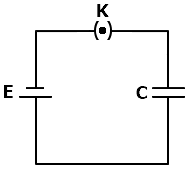The electrostatic potential on the surface of a charged conducting sphere is \(100~\text{V}\). Two statements are made in this regard.
Statement I:
At any point inside the sphere, electric intensity is zero.
Statement II:
At any point inside the sphere, the electrostatic potential is \(100~\text{V}\).
Which of the following is a correct statement?
1.
Statement I is true but Statement II is false.
2.
Both Statement I and Statement II are false.
3.
Statement I is true, Statement II is also true and Statement I is the cause of Statement II.
4.
Statement I is true, Statement II is also true but the statements are independent.
Which of the following is a correct statement?
Equipotential at a great distance from a collection of charges whose total sum is not zero are approximately:
| 1. | spheres | 2. | planes |
| 3. | paraboloids | 4. | ellipsoids |
A parallel plate capacitor is made of two dielectric blocks in series. One of the blocks has thickness d1 and dielectric constant K1 and the other has thickness d2 and dielectric constant K2, as shown in the figure. This arrangement can be thought of as a dielectric slab of thickness d = d1 + d2 and effective dielectric constant K. K is:

| 1. | \(\frac{\mathrm{K}_{1} \mathrm{~d}_{1}+\mathrm{K}_{2} \mathrm{~d}_{2}}{\mathrm{~d}_{1}+\mathrm{d}_{1}}\) | 2. | \(\frac{\mathrm{K}_{1} \mathrm{~d}_{1}+\mathrm{K}_{2} \mathrm{~d}_{2}}{\mathrm{~K}_{1}+\mathrm{K}_{2}}\) |
| 3. | \(\frac{\mathrm{K}_{1} \mathrm{~K}_{2}\left(\mathrm{~d}_{1}+\mathrm{d}_{2}\right)}{\mathrm{K}_{1} \mathrm{~d}_{2}+\mathrm{K}_{2} \mathrm{~d}_{1}}\) | 4. | \(\frac{2 \mathrm{~K}_{1} \mathrm{~K}_{2}}{\mathrm{~K}_{1}+\mathrm{K}_{2}}\) |
Consider a uniform electric field in the Z-direction. The potential is constant:
| a. | in all space |
| b. | for any x for a given z |
| c. | for any y for a given z |
| d. | on the x-y plane for a given z |
1. (a, b, c)
2. (a, c, d)
3. (b, c, d)
4. (c, d)
Equipotential surfaces:
| a. | are closer in regions of large electric fields compared to regions of lower electric fields. |
| b. | will be more crowded near the sharp edges of a conductor. |
| c. | will be more crowded near regions of large charge densities. |
| d. | will always be equally spaced. |
Choose the correct statement(s):
1. a, b and c
2. a, c and d
3. b, c and d
4. c and d
3 Figure shows some equipotential lines distributed in space. A charged object is moved from point A to point B.
(a) The work done in Fig. (i) is the greatest
(b) The work done in Fig. (ii) is least
(c) The work done is the same in Fig. (i), Fig. (ii) and Fig. (iii)
(d) The work done in Fig. (iii) is greater than Fig. (ii) but equal to that in Fig. (i)
(i) Fig. (ii) Fig. Fig(iii)
2. A positively charged particle is released from rest in a uniform electric field. The electric potential energy of the charge:
(a) remains constant because the electric field is uniform.
(b) increases because the charge moves along the electric field.
(c) decreases because the charge moves along the electric field.
(d) decreases because the charge moves opposite to the electric field.
A parallel plate capacitor is connected to a battery as shown in the figure. Consider two situations.
| A: | Key K is kept closed and plates of capacitors are moved apart using the insulating handle. |
| B: | Key K is opened and plates of capacitors are moved apart using the insulating handle. |
Choose the correct option(s):
| a. | In A, Q remains the same but C changes. |
| b. | In B, V remains the same but C changes. |
| c. | In A, V remains the same and hence Q changes. |
| d. | In B, Q remains the same and hence V changes. |
1. a and b
2. a and d
3. b and c
4. c and d
If a conductor has a potential V 0 and there are no charges anywhere else outside, then
(a) there must be charges on the surface or inside itself
(b) there cannot be any charge in the body of the conductor
(c) there must be charges only on the surface
(d) there must be charges inside the surface
(1) (a, c)
(2) (a, d)
(3) (a, b)
(4) (c, d)
In the circuit shown in the figure initially key K1 is closed and key K2 is open. Then K1 is opened and K2 is closed (order is important).
[Take Q1 and Q2 as charges on C1 and C2 and V1 and V2 as voltage respectively.]
Then,
| a. | charge on C gets redistributed such that V1 = V2 |
| b. | charge on C gets redistributed such that Q1 = Q2 |
| c. | charge on C gets redistributed such that C1V1 + C2V2 = C1E |
| d. | charge on C gets redistributed such that Q1+ Q2 = Q |
Choose the correct statement(s)
1. a and c
2. a and d
3. b and c
4. c and d





